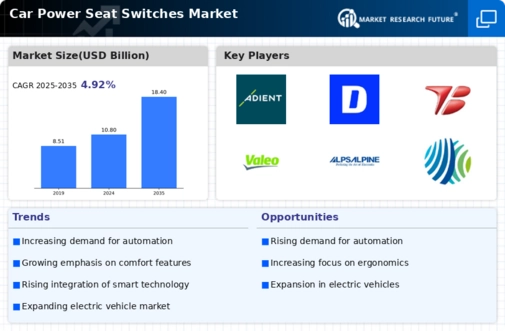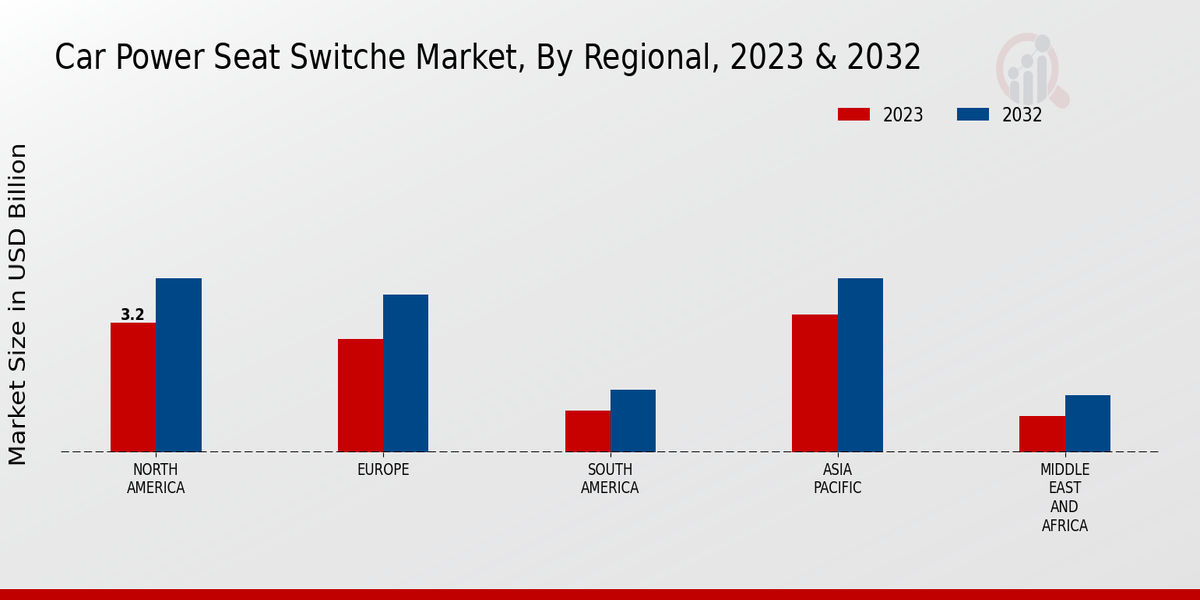Market Growth Projections
The Global Car Power Seat Switches Market Industry is poised for substantial growth, with projections indicating a market value of 10.8 USD Billion in 2024 and an expected increase to 18.4 USD Billion by 2035. This growth trajectory suggests a compound annual growth rate (CAGR) of 4.92% from 2025 to 2035. Such figures reflect the increasing integration of power seat switches in vehicles, driven by consumer demand for comfort, safety, and technological advancements. The market's expansion is likely to be influenced by various factors, including the rise of electric vehicles and the ongoing evolution of automotive design.
Growing Focus on Safety Features
The growing emphasis on safety features in vehicles is a significant driver for the Global Car Power Seat Switches Market Industry. Manufacturers are increasingly integrating safety mechanisms into power seat switches, such as automatic shut-off features and child safety locks. This focus on safety is not only a response to regulatory requirements but also aligns with consumer expectations for safer driving environments. As the market evolves, the incorporation of these features is likely to enhance the appeal of power seat switches, contributing to the projected market growth. The increasing awareness of safety in automotive design underscores the importance of these innovations.
Increasing Vehicle Electrification
The ongoing trend of vehicle electrification is a pivotal driver for the Global Car Power Seat Switches Market Industry. As manufacturers transition to electric vehicles, the demand for advanced electronic components, including power seat switches, is expected to rise. This shift is evidenced by the projected market value of 10.8 USD Billion in 2024, reflecting a growing preference for electric and hybrid vehicles. The integration of power seat switches into these vehicles not only enhances comfort but also aligns with the overall trend towards automation and smart features, thereby propelling the market forward.
Technological Advancements in Automotive Design
Technological advancements in automotive design are driving innovation within the Global Car Power Seat Switches Market Industry. The integration of smart technologies, such as touch-sensitive controls and connectivity features, is reshaping how power seat switches function. These advancements not only improve user experience but also align with the industry's push towards more sophisticated vehicle interiors. As a result, the market is expected to grow at a CAGR of 4.92% from 2025 to 2035, reflecting the increasing incorporation of technology in automotive components. This trend highlights the importance of staying ahead in a competitive landscape where consumer expectations are continually evolving.
Rising Consumer Demand for Comfort and Customization
Consumer preferences are evolving towards greater comfort and customization in vehicles, significantly impacting the Global Car Power Seat Switches Market Industry. As consumers increasingly seek personalized driving experiences, the demand for adjustable power seats equipped with advanced switches is likely to surge. This trend is supported by the anticipated growth of the market to 18.4 USD Billion by 2035, indicating a robust interest in features that enhance driving comfort. Manufacturers are responding by incorporating innovative designs and functionalities, such as memory settings and lumbar support, which are becoming standard in modern vehicles.
Expansion of the Automotive Industry in Emerging Markets
The expansion of the automotive industry in emerging markets is a crucial driver for the Global Car Power Seat Switches Market Industry. As economies in regions such as Asia-Pacific and Latin America continue to grow, the demand for vehicles equipped with advanced features, including power seat switches, is expected to rise. This trend is indicative of a broader shift towards modernization and improved vehicle standards in these markets. The anticipated growth trajectory of the market, reaching 18.4 USD Billion by 2035, suggests that manufacturers are likely to invest heavily in these regions to capitalize on the burgeoning consumer base seeking enhanced automotive features.












